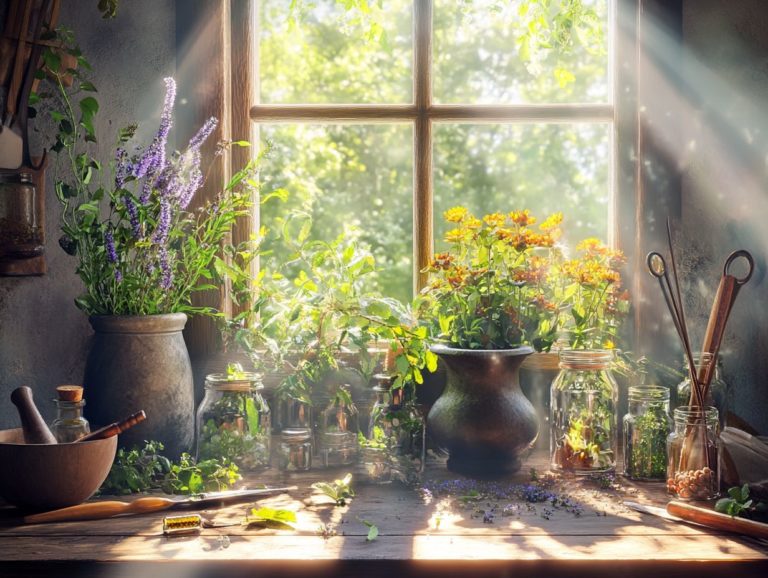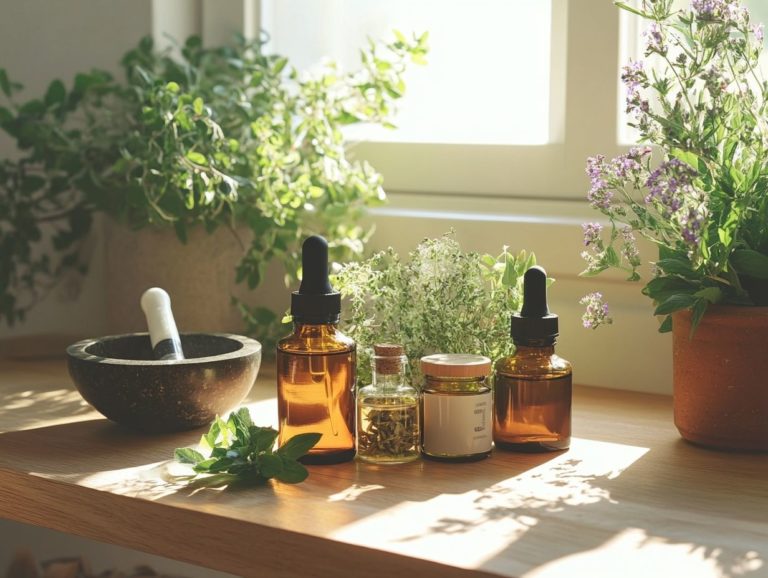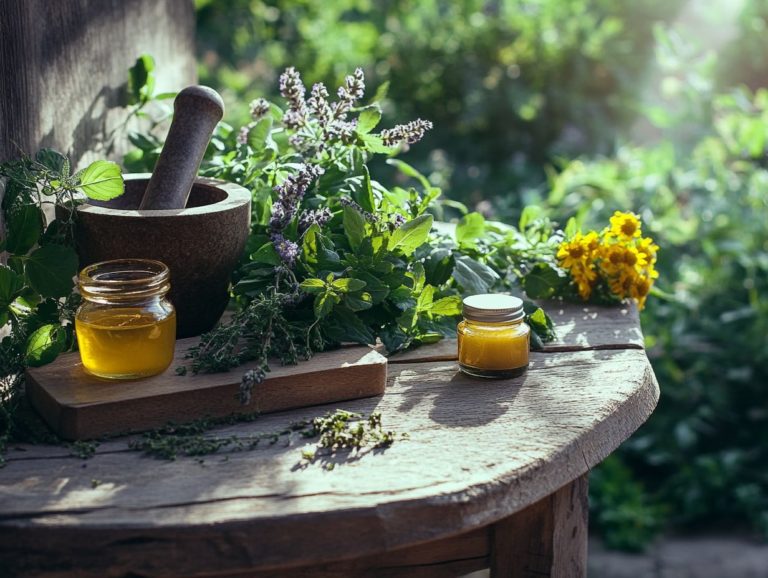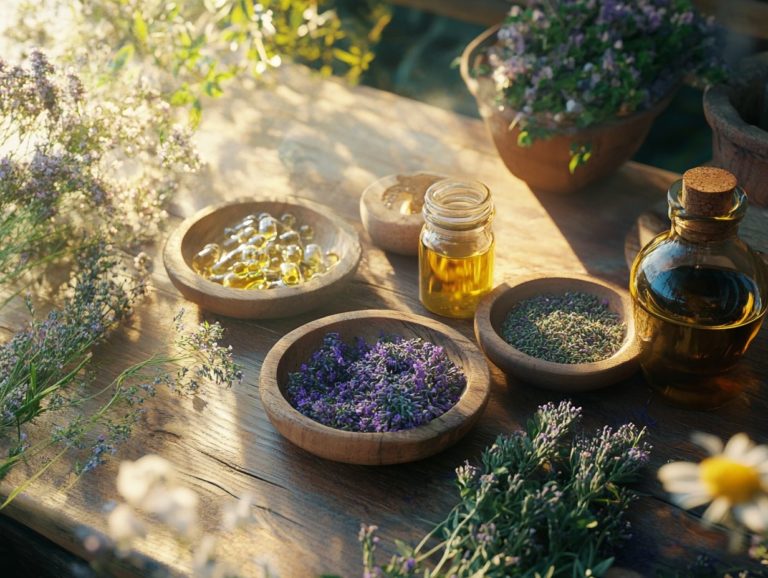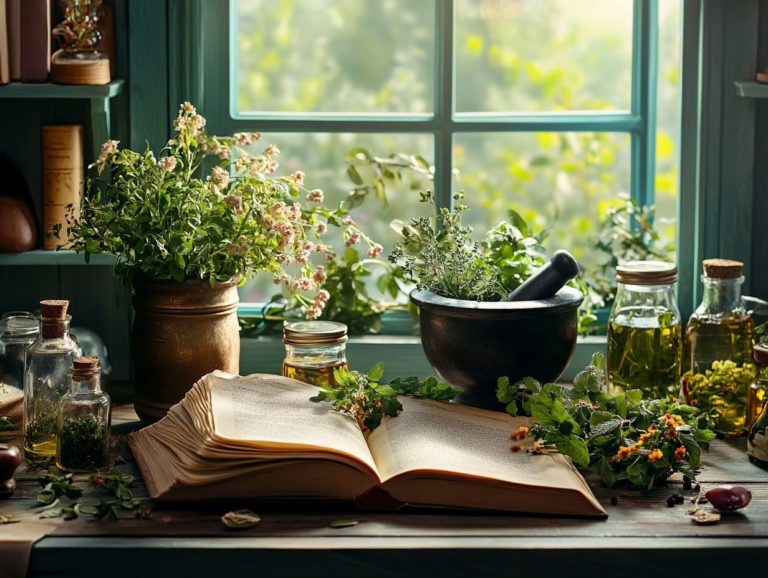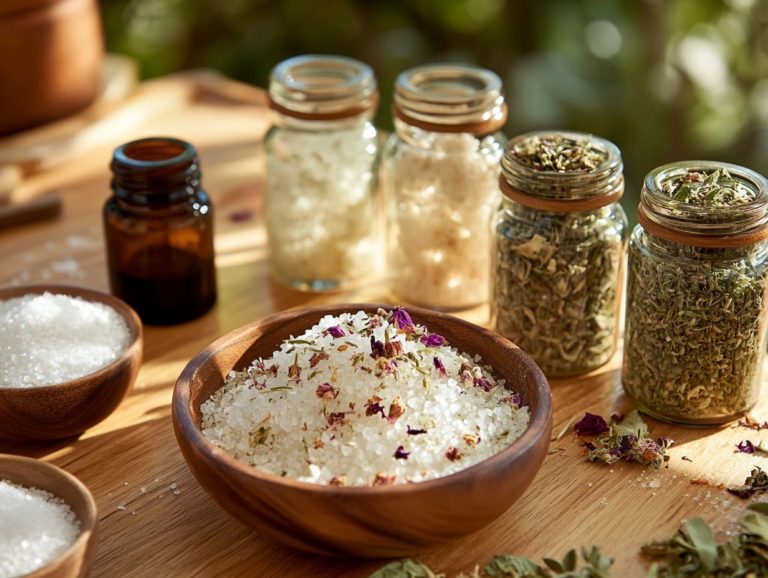Herbal Infusions: Methods and Benefits
Herbal infusions present a delightful and healthful way for you to savor a rich variety of flavors and benefits straight from nature.
Often mistaken for tea, these vibrant brews are crafted from a diverse selection of herbs, each contributing its own unique properties.
You can explore an array of methods for creating herbal infusions, whether you prefer hot or cold techniques, or perhaps the charming sun tea approach.
Uncover the health benefits associated with different herbs, along with tips for brewing the perfect infusion. You ll also find creative ideas for seamlessly incorporating these soothing drinks into your daily routine.
Whether you re a seasoned herbalist or simply a curious novice, exciting discoveries await you here!
Contents
- Key Takeaways:
- What are Herbal Infusions?
- Methods for Making Herbal Infusions
- Benefits of Herbal Infusions
- Choosing the Right Herbs for Infusions
- Tips for Brewing the Perfect Herbal Infusion
- Proper Brewing Techniques
- Incorporating Herbal Infusions into Your Daily Routine
- Frequently Asked Questions
- What are herbal infusions and what are their benefits?
- What are the different methods of creating herbal infusions?
- What herbs are commonly used in herbal infusions?
- How do I prepare a hot herbal infusion?
- What is the difference between an herbal infusion and herbal tea?
- Can I mix different herbs together to create my own herbal infusion blend?
Key Takeaways:
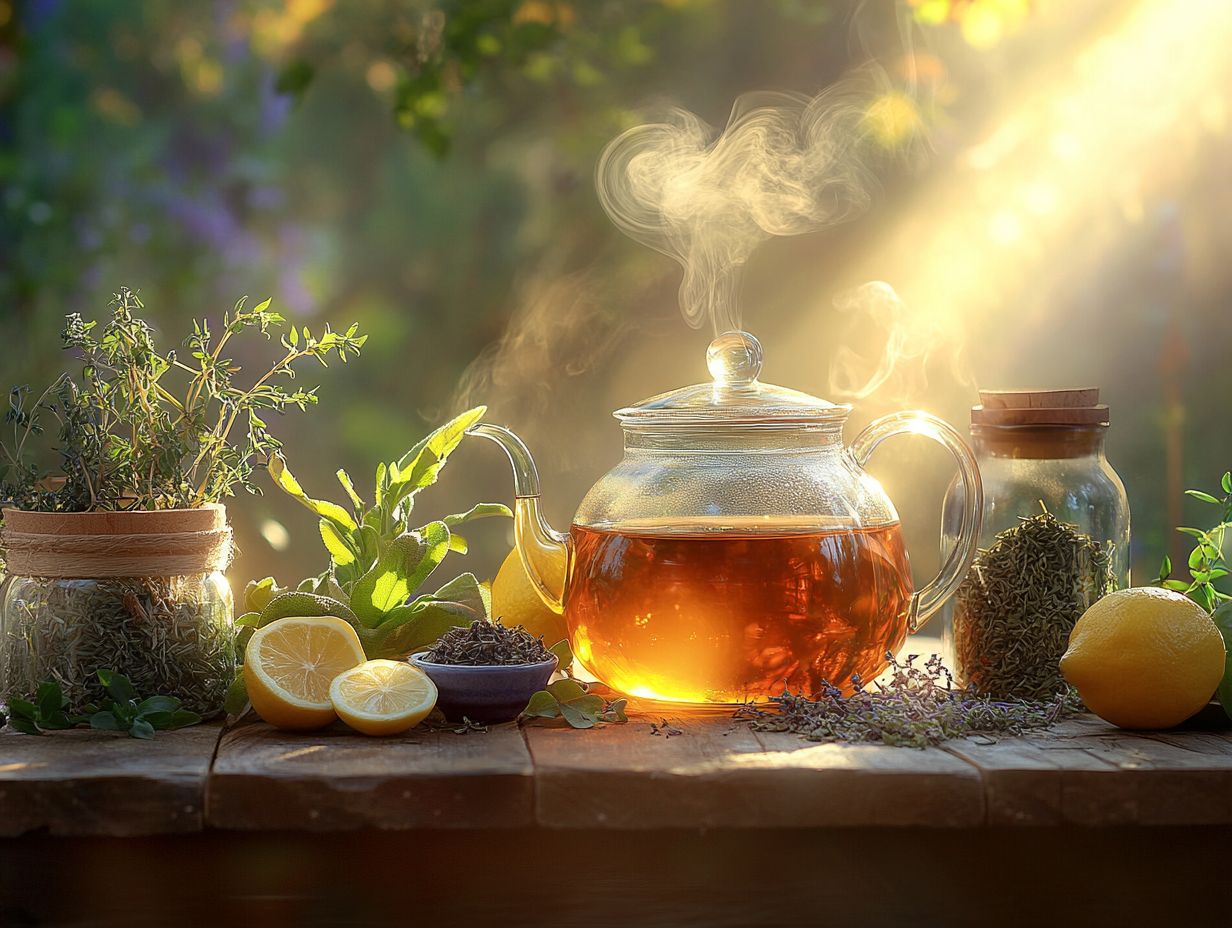
- Herbal infusions are a delicious alternative to traditional tea, offering a variety of flavors and health benefits.
- Explore methods like hot, cold, and sun tea for unique flavors.
- Learn how to choose the right herbs for your wellness routine.
What are Herbal Infusions?
Herbal infusions, often called herbal teas, are your gateway to a world of flavor and wellness. By steeping herbs in hot water (soaking herbs in hot water), you can extract their health benefits and beneficial properties, creating delightful beverages that not only soothe the senses but also serve as natural health remedies.
Unlike traditional tea, which relies on the leaves of Camellia sinensis, herbal infusions open the door to a vast array of plants, from calming chamomile to invigorating peppermint and zesty ginger. This versatility enables you to tap into the remarkable benefits of herbs, whether for enjoyment or therapeutic purposes.
Definition and Differences from Tea
The primary distinction between herbal infusions and traditional tea lies in their ingredients and preparation methods. Herbal infusions utilize a diverse array of herbs, while traditional tea is crafted exclusively from the leaves of the Camellia sinensis plant.
Traditional tea encompasses varieties like black, green, white, and oolong, each with its own unique flavors and health benefits. In contrast, herbal infusions might range from the soothing notes of chamomile to the invigorating zest of peppermint or the warming spice of ginger.
To create a herbal infusion, you typically steep these dried or fresh herbs in hot water for an extended period, allowing the flavors and beneficial compounds to meld fully. Unlike traditional tea, which can contain caffeine and tannins, herbal infusions are generally caffeine-free and can provide a wealth of health benefits, such as aiding digestion or promoting relaxation. This makes them a versatile and enriching addition to any wellness routine, especially for those exploring herbal preparations and remedies.
Methods for Making Herbal Infusions
In terms of crafting herbal infusions, you have a delightful array of methods at your disposal. Whether you choose hot infusion, cold infusion, or the sun tea technique, each method presents its own unique advantages and flavor profiles, inviting you to explore and savor the nuances of each approach.
Hot Infusion, Cold Infusion, and Sun Tea
Hot infusion is all about steeping those herbs in boiling water, while cold infusion takes a more laid-back approach, using cold water and allowing for longer steeping times. Then there s sun tea, a delightful method that harnesses sunlight to gently coax out the flavors and benefits from the herbs.
Each infusion method brings its own unique flair, enhancing or transforming your herbal experience. For example, when you opt for hot infusion, you quickly extract a herb’s essential oils and flavors perfect for bold choices like ginger or chamomile. On the flip side, cold infusion lets delicate herbs like mint or lemon balm infuse gracefully, resulting in a milder yet refreshingly vibrant flavor. To learn more about the benefits of herbal tea, check out the science behind herbal tea benefits.
Now, sun tea is an art form that teaches you the value of patience. It relies on the sun s warmth to draw out the herbs properties over several hours, often producing a sweeter, smoother beverage that captures the essence of summer. By understanding these nuances, you not only elevate your tasting experience but also tailor your approach to the unique health benefits each method can provide.
Start your herbal infusion journey today! Try making your own blends, including lavender tea, and share your experiences with others.
Benefits of Herbal Infusions
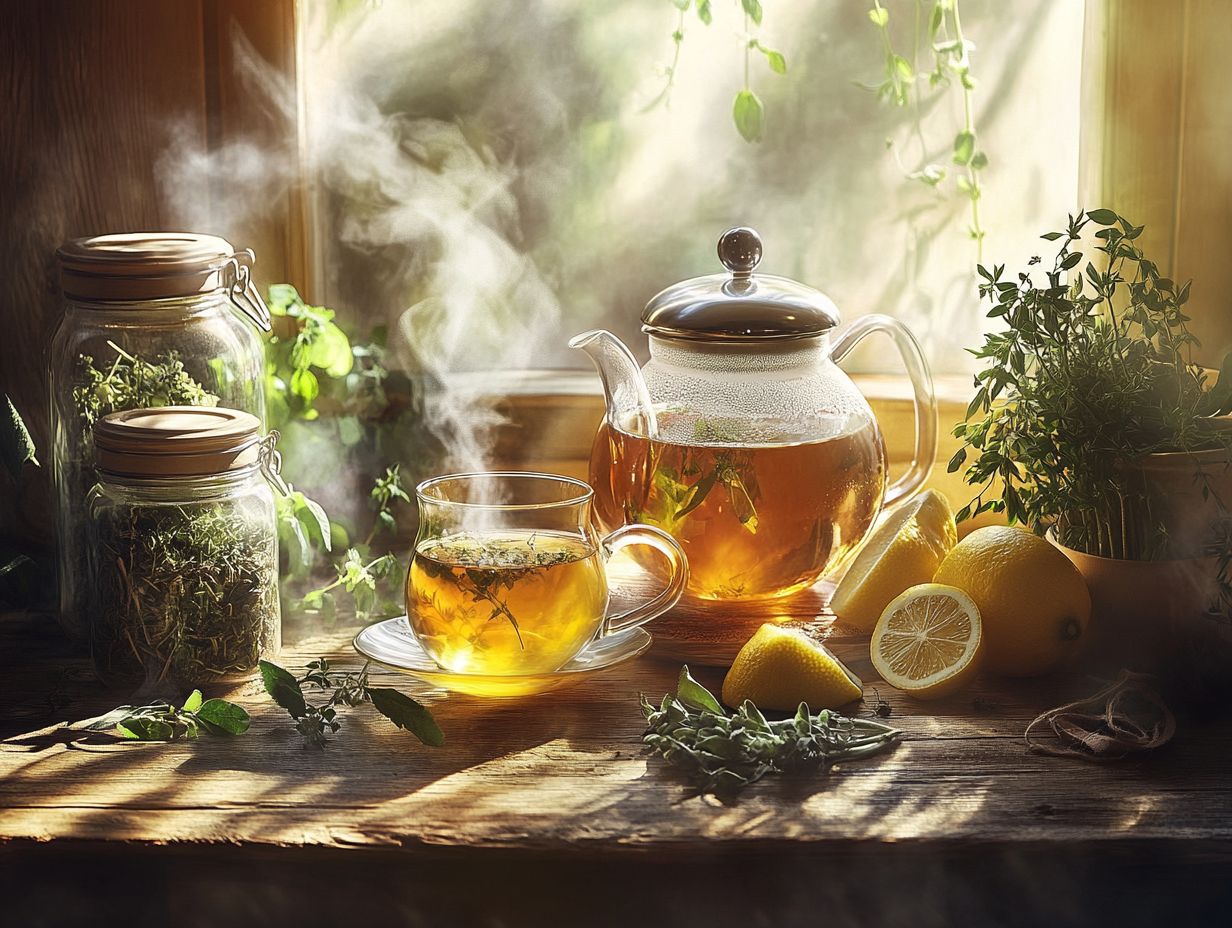
Herbal infusions offer a wealth of health benefits, ranging from enhancing digestive health to easing anxiety. It’s no wonder they have become a favored option for anyone in search of natural remedies for a variety of ailments.
Health Benefits of Different Herbs
Different herbs used in herbal infusions offer unique health benefits. For instance, chamomile tea is known for its calming effects, while ginger tea shines for its impressive anti-inflammatory properties.
Peppermint delights your palate with its refreshing flavor and supports digestion. It also alleviates headaches, making it a preferred option for those seeking relief from discomfort through herbal remedies.
Imagine sipping a warm cup of chamomile after a long day, while the warm, spicy notes of ginger invigorate your senses and promote circulation. These herbs contribute to your overall health and enhance the enjoyment of each sip, transforming a daily ritual into a delightful health-boosting experience. To fully appreciate their benefits, it’s important to understand herbal extraction methods and dosages.
Other Benefits and Uses
Herbal infusions are remarkably versatile remedies. Use these infusions to nourish your skin naturally and can easily be added to creams, lotions, and serums to enhance hydration and elasticity.
For example, chamomile infusions work wonders by soothing irritations, while lavender extracts bring calming properties that can improve your overall skin tone.
You can also incorporate herbal infusions into DIY face masks and hair rinses, harnessing their antioxidant qualities to help protect your cells from damage and promote follicle health. To ensure you are using them safely, refer to these 5 dosage tips for herbal infusions.
Choosing the Right Herbs for Infusions
Choosing the right herbs for your infusions is essential, as each herb presents unique health benefits and flavors that can elevate your herbal preparations and remedies.
Factors to Consider
When selecting herbs for your herbal infusions, consider your personal health concerns, flavor preferences, and the specific benefits each herb offers. This thoughtful approach enhances your experience and aligns your infusion with your wellness goals.
If you’re dealing with stress, digestive issues, or sleep disturbances, choosing herbs like chamomile or peppermint can directly address those needs. For a comprehensive approach, consider herbal tea: a natural approach to wellness. Taste is equally important; explore options like hibiscus for a tangy zest or lavender for its calming fragrance to ensure that your infusion is both delightful and advantageous.
Experimenting with various combinations allows you to craft unique blends that resonate with your health objectives and personal taste, creating herbal tonic options tailored to your needs.
Tips for Brewing the Perfect Herbal Infusion
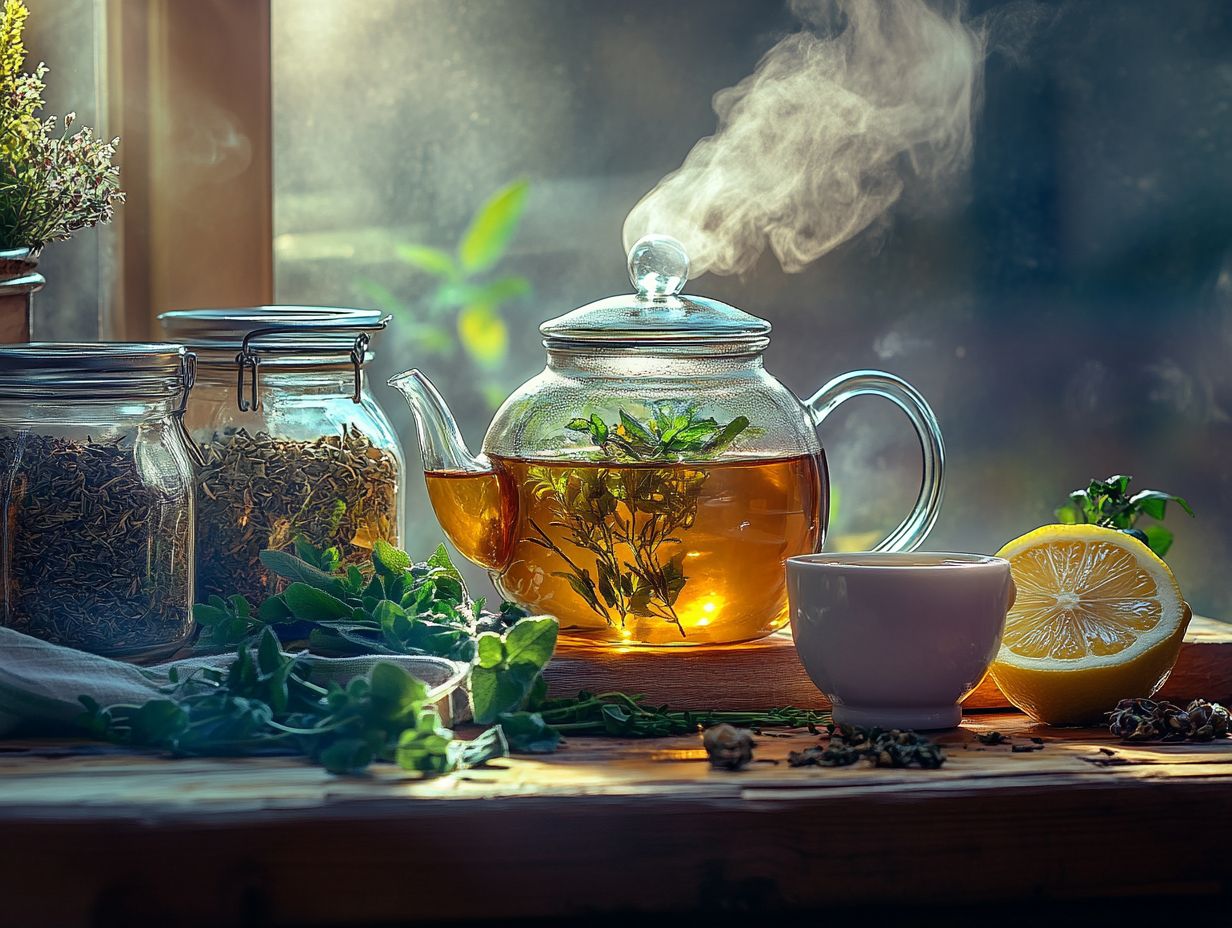
To craft the perfect herbal infusion, adhere to certain tips and techniques that enhance flavor and ensure optimal extraction of the herbs’ medicinal properties. Each step is an art designed to elevate your infusion to its fullest potential.
Start your herbal journey now and experience the benefits for yourself!
Proper Brewing Techniques
Proper brewing techniques are crucial when crafting herbal infusions. The right steeping time and water temperature profoundly affect both the flavor and effectiveness of your brew, especially with different herbs that may have varying properties.
Understanding these herbs is vital for anyone eager to create the perfect cup. For example, delicate herbs like chamomile thrive at lower water temperatures around 200 F and require a steeping time of just 5 to 7 minutes to fully extract their soothing properties without introducing bitterness. This makes them ideal for soothing teas.
On the other hand, robust herbs like peppermint prefer boiling temperatures (212 F) and benefit from a longer steep typically around 10 minutes to release their invigorating oils and flavors, enhancing their role in herbal medicine.
By fine-tuning both the temperature and steeping time based on the specific herbs, you can customize each infusion to achieve not just the desired taste but also optimal health benefits for various health issues.
Incorporating Herbal Infusions into Your Daily Routine
Incorporating herbal infusions into your daily routine offers a delightful opportunity to elevate your health with flavorful beverages designed to align with your wellness goals. They can be an integral part of your natural ways to improve health.
Ideas for Incorporating Infusions into Meals and Drinks
Add a burst of flavor and health to your meals with herbal infusions! They introduce unique flavors and health benefits that truly enhance your culinary experiences and promote natural health.
Imagine a fragrant basil-infused broth serving as a delightful base for your soups, adding depth and a fresh aroma to classic recipes. Consider blending chamomile tea into your homemade salad dressings for a soothing twist that complements greens beautifully and supports digestive health. Additionally, incorporating herbal tea into your daily routine can further enhance your well-being.
Your smoothies can achieve a new level of deliciousness by trying to mix in a refreshing mint infusion with spinach, banana, and yogurt and even a hint of ginger tea for a revitalizing start to your day. The possibilities are endless, allowing you to showcase the vibrant essence of herbal goodness in every meal and explore various herbal recipes.
Frequently Asked Questions
What are herbal infusions and what are their benefits?
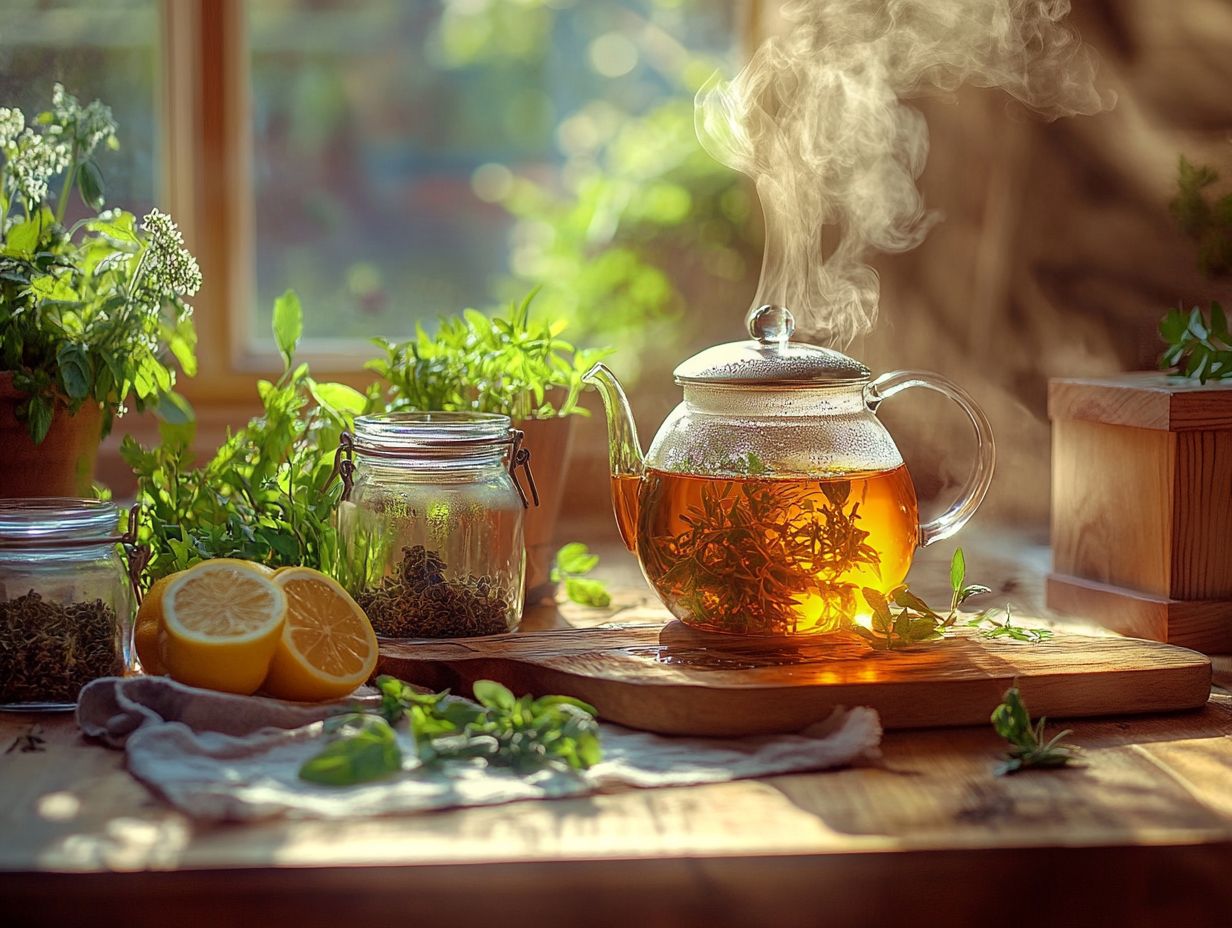
Herbal infusions are beverages made by steeping herbs, fruits, or spices in hot water. They offer numerous health benefits, including boosting the immune system, aiding digestion, and promoting relaxation while providing essential medicinal properties.
What are the different methods of creating herbal infusions?
There are several methods for making herbal infusions, including hot infusion, cold infusion, and sun infusion. Each method involves steeping the herbs in water for a certain amount of time to extract their medicinal properties and enhance their medicinal value.
What herbs are commonly used in herbal infusions?
Some popular herbs used in herbal infusions include chamomile, peppermint, ginger, and lemon balm. Each herb has its own unique health benefits and flavor profile, making it easy to find a blend that suits your needs and addresses various health issues.
How do I prepare a hot herbal infusion?
To prepare a hot herbal infusion, place your desired herbs in a tea strainer or infuser and pour hot water over them. Allow the herbs to steep for 5-10 minutes, then remove the strainer and enjoy your herbal infusion, enhancing your overall health benefits.
What is the difference between an herbal infusion and herbal tea?
The main difference between an herbal infusion and herbal tea is the steeping time. Herbal infusions typically require a longer steeping time, allowing for more of the herb’s medicinal properties to be extracted, while herbal teas are steeped for a shorter period, making them great for quick soothing teas.
Try making your own herbal infusions today and discover the amazing benefits they can bring! Share your experiences and favorite recipes with others!
Can I mix different herbs together to create my own herbal infusion blend?
Yes, you can mix different herbs to make a unique herbal infusion. It’s fun to experiment with flavors!
Research the herbs before mixing. Choose those that taste good together and offer health benefits. For example, eucalyptus oil, derived from the leaves of the eucalyptus tree, is known for supporting respiratory health.

